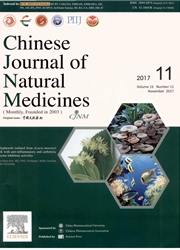

 中文摘要:
中文摘要:
Chuanwu (CW ) ,从 Aconitum carmichaelii Debx 的母亲根的著名繁体中文药(TCM ) ……(Ranunculaceae ) ,被用于各种各样的疾病的处理。不幸地,因为它的狭窄的治疗学的窗户,它的毒性经常被报导。在现在的学习,一个 metabolomic 方法被执行描绘 phenotypically 生物化学的不安和导致 CW 的毒性的潜在的机制。同时,在尿的毒性 biomarkers 的表示水平被分析与 Gancao 由联合评估 detoxification (根值 Glyeyrrhizae, CG ) , Baishao (根值 Paeoniae Alba, CS ) 并且 Ganjiang (根茎 Zingiberis, CJ ) ,它从古典 TCM 药方被屏蔽。尿 metabolomics 被 UPLC-Q-TOF-HDMS,和集体系列执行检测代谢物的信号系统地用模式识别方法被分析。作为结果,与 CW 毒性联系的十七 biomarkers 被识别,它与戊糖和 glucuronate 被联系互变现象,丙氨酸, aspartate,和 glutamate 新陈代谢,在其它之中。大多数毒性 biomarkers 的表示层次被相容性药有效地向正常范围调制。它显示三相容性药能有效地除去 CW。在摘要,我们的工作证明 metabolomics 为 TCM 对毒性和发现 detoxification 方法的评估极其重要。
 英文摘要:
英文摘要:
Chuanwu(CW), a famous traditional Chinese medicine(TCM) from the mother roots of Aconitum carmichaelii Debx..(Ranunculaceae), has been used for the treatment of various diseases. Unfortunately, its toxicity is frequently reported because of its narrow therapeutic window. In the present study, a metabolomic method was performed to characterize the phenotypically biochemical perturbations and potential mechanisms of CW-induced toxicity. Meanwhile, the expression level of toxicity biomarkers in the urine were analyzed to evaluate the detoxification by combination with Gancao(Radix Glyeyrrhizae, CG), Baishao(Radix Paeoniae Alba, CS) and Ganjiang(Rhizoma Zingiberis, CJ), which were screened from classical TCM prescriptions. Urinary metabolomics was performed by UPLC-Q-TOF-HDMS, and the mass spectra signals of the detected metabolites were systematically analyzed using pattern recognition methods. As a result, seventeen biomarkers associated with CW toxicity were identified, which were associated with pentose and glucuronate interconversions, alanine, aspartate, and glutamate metabolism, among others. The expression levels of most toxicity biomarkers were effectively modulated towards the normal range by the compatibility drugs. It indicated that the three compatibility drugs could effectively detoxify CW. In summary, our work demonstrated that metabolomics was vitally significant to evaluation of toxicity and finding detoxification methods for TCM.
 同期刊论文项目
同期刊论文项目
 同项目期刊论文
同项目期刊论文
 Rapid identification and comparative analysis of chemical constituents and metabolites of Phellodend
Rapid identification and comparative analysis of chemical constituents and metabolites of Phellodend Chemical Discrimination of Cortex Phellodendri amurensis and Cortex Phellodendri chinensis by Multiv
Chemical Discrimination of Cortex Phellodendri amurensis and Cortex Phellodendri chinensis by Multiv Rapid discovery and global characterization of chemical constituents and rats metabolites of Phellod
Rapid discovery and global characterization of chemical constituents and rats metabolites of Phellod Identification and characterization of the chemical constituents of Simiao Wan by ultra high perform
Identification and characterization of the chemical constituents of Simiao Wan by ultra high perform Fingerprinting and simultaneous determination of alkaloids and limonins in Phellodendri amurensis co
Fingerprinting and simultaneous determination of alkaloids and limonins in Phellodendri amurensis co UPLC-MS coupled with a dynamic multiple data processing method for the comprehensive detection of th
UPLC-MS coupled with a dynamic multiple data processing method for the comprehensive detection of th 期刊信息
期刊信息
